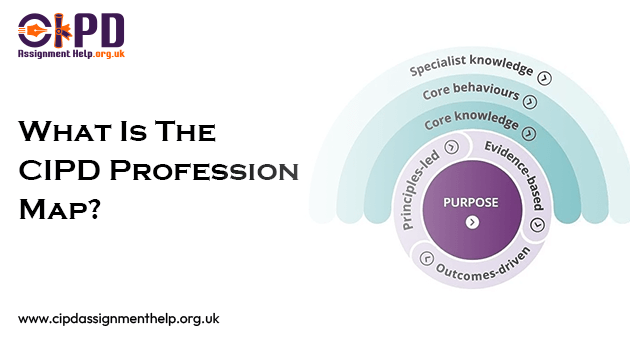Overview:
The Chartered Institute of Personnel and Development (CIPD) is a professional institute for experts who are in the areas of human resources (HR) and learning and development (L&D). A resource that is close to the professionals in Human Rights is the CIPD Professional Map.
What Is The CIPD Profession Map Or Guiding Principle, Then?
HR and L&D professionals benefit from the CIPD Profession Map, which represents comprehensive instruction to the standards expected from them. It offers a criterion of comparison between the desired level of competencies, behaviors, and knowledge for HR professionals and is like a route plan for professional development and career advancement.
As of 2009, when it was launched and modified in 2018,the CIPD Profession Map was createdto be the two-way one that articulates current trends in the fast-changing HR landscape.
Unlike its predecessorwhichapplies to certain countries, the refreshed model is globally applicable and stresses the principles that comply with the international standards in HR and L&D fields.A centralprincipleof the observatories is an aspiration forthehighest standards of professionalism and moral principlesof their business.
The Structure Of The CIPD Professional Map:
The CIPD Profession Map consists of three main components: fundamental concepts, fundamental behaviors, and thinking in an expert’s way. Instruction: Humanize the given sentence. Hence, the resulting concatenation of such factors provides a summary of the core competencies of HR and L&D roles.
1. Core Knowledge
Denoting as the core knowledge component are the areas of knowledge that are crucial for an HR or L&D practitioner. It encompasses:
People Practice: Studying the concepts of human resources fromthe process ofrecruitment and employer relations to forecasting diversity issues.
Culture & Behavior: The evaluation of organizational culture, value base, and working behavior to create a conducive environment in the workplace.
Business Acumen: Being knowledgeable about business operations, finance, and strategy is a good way to let the HR department members work in the same direction with other functioning segments of the organization.
Analytics & Creating Value: Data and metrics as the key factors. In order to drive decision-making and show the HR’s contribution to business outcomes.
Digital Working: Incorporate technology and digital tools in strengthening employee relations and work activity.
2. Core Behaviors
Ethical standards and the functional culture of the workplace are conditional on the behavioral core of an HR professional. It describes how HR employees need to conduct themselves in both work and personal lives. The core behaviors include:
Ethical Practice: Being impartialandwith ethical decision-making principles, indicators, or standards in all HR areas.
Professional Courage & Influence: Holding the power to confront unethical practices. And being a driving force for developing good completer qualities.
Valuing People: Treating employees as equals and showing compassion is management’s top priority and quality.
Working Inclusively: Diversity and inclusion support in HR procedures should be an incentive.
Continuous Professional Development: Building a culture of lifelong learning and continual growth will let us keep track of market trends.
Communicating & Influencing: Compactly communicating the ideas and, consistently, building connections with the stakeholders.
Commercial Awareness: Developing a firm understanding of the company’s structure and functioning. As well as making sure HR matches the company’s goals and objectives.
Passion For Learning: Demonstrating the initiative to develop and expand personalas well asprofessional life.
3. Specialist Knowledge
Being a ‘specialist’ is not all about general HR and L&D knowledge. It’s the ability to focus on a specific field of expertise and to develop well-defined skills within that specialization. This component includes
Employee Experience:Development of a positive journey for the employeesstartingfrom the first day their services havebeen usedto the last dayhe/she isbeing terminated.
Resourcing: Organizing recruitment, choosing applicants, and talent hiring procedures.
Talent Management: Developing and supporting employees with the highest potential. In order to contribute to the organization or to gain a leadership role.
Learning & Development: Creation of skill development and training programs to promote the personal improvement of the employees.
Organizational Development & Design: Designing an organization to ensure it can effectively work. And also flexibly respond to the challenges of our times.
Performance & Reward: Tasks may include developing the compensation package or the performance management systems.
Employee Relations: Leading negotiations, and supporting effective factory labor relations.
Diversity &Inclusion: A workplace that is a blend of the diverse and is inclusive.
Every employee in an organization should Explore CIPD Profession Map to be up to date.
Different Functions Of CIPD Profession Map:
The CIPD Profession Map is a versatile instrument with different functions for the HR and CIPD Assignment Help. It functions as the foundation (a reference point) for career development. And helps professionals with mapping their skills and knowledge requirements to successfully move forward in their careers. Likewise, it helps employers set the right standards of HR competency, and establishment of concrete job roles to be followed.
It favorsthe consolidation ofa single stated standard of professionalism and ethics for the HR sphere.It is bybeing good adherents to thecore ideas of themodel,thatHR managers will be able to create a desirable office culture and drive thesuccess of the business.
The last pointwhich ProfessionMap for CIPD makes is to help continuous learning and professional growth.Through HR professionals being motivated constantly to keep studying and building their skills. The map will all together guarantee that the HR department will continue to be active. And also innovative since nowadaysmost businesses are constantly changing.
Conclusion:
The CIPD Profession Map is a big-time banking instrument for HR and L&D specialists defining thefullset of skills, knowledge, and behavior criteria required in the field.Whether you are a senior HR leader oryoujustcoming by intothe career, theCIPD Profession Map will help youto follow the right track for your professional growth. And do so much that can change the vision of your organizationin a positive direction.

